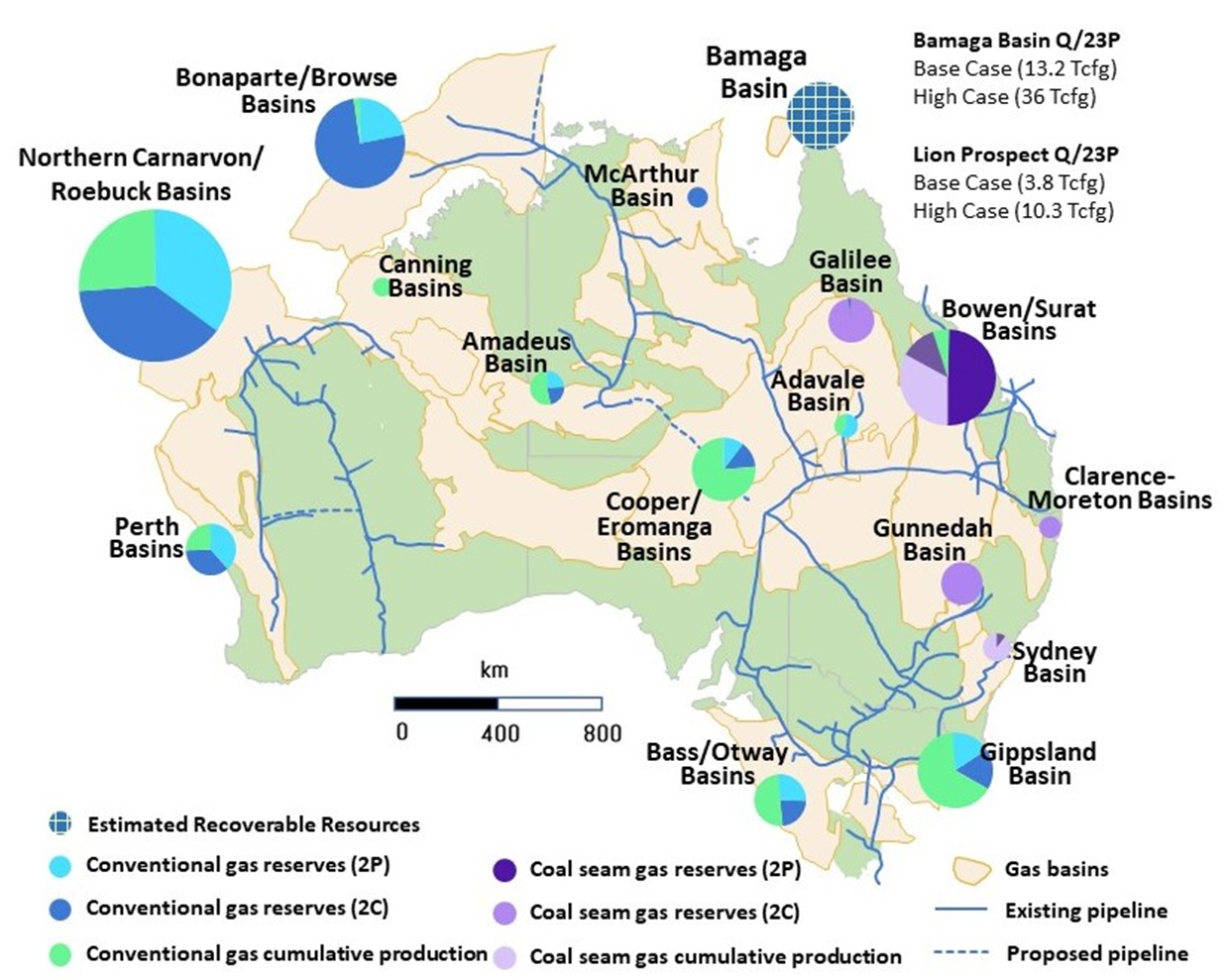The Bamaga Basin is potentially the fourth largest remaining gas resource in Australia
“We usually find gas in new places with old ideas. Sometimes, also, we find gas in an old place with a new idea, but we seldom find much gas in an old place with an old idea.
Several times in the past we have thought we were running out of gas, whereas actually we were only running out of ideas.”
- Parke A. Dickey, geologist (1910 - 1995)
The Significance of the Bamaga Basin
Gulf Energy has secured exploration acreage (Q/23P) over an entire, new, offshore petroleum basin with estimated recoverable gas resources that could make it the fourth largest remaining gas resource in Australia, covering over 7,500 sq km in shallow, 70m waters and only 150km from shore.
The largest currently known remaining 2P gas reserves and 2C gas resources are in the Bonaparte/Browse and Northern Carnarvon/Roebuck Basins for conventional and the Bowen/Surat Basins for coal seam gas.
There have been no new gas discoveries in recent years that have materially added to Australia’s gas reserves such that the depletion of current gas reserves has been arrested or reversed. The Bamaga Basin, discovered by Gulf Energy in 2012, is expected to add substantial new gas reserves for Australia.
The Bamaga Basin could, in the Base Case, hold 13.2 Tcf of recoverable gas resources and up to 36 Tcf in the High Case. The Lion Prospect alone could, in the Base Case, hold 3.8 Tcf recoverable gas resources and in the High Case as much as 10.3 Tcf recoverable resources. In terms of energy equivalency, the Gulf Energy estimates the Bamaga Basin license could have more than 6 Billion barrels of oil (equivalency), with the Lion Prospect 1.7 Billion barrels of oil (equivalency).
The above map shows graphically how the gas resources potential of the Bamaga Basin compares very favourably with the gas resources potential of Australia’s other sedimentary basins.
Gulf Energy has a basin master position controlling ALL the potential
The Bamaga Basin was discovered by Gulf Energy in 2012 when it acquired high quality, modern marine seismic data in the Gulf of Carpentaria, offshore Australia. Although the area had been explored earlier by several companies, they had missed the deeper potential that lay beneath where they were searching.
Gulf Energy has so far identified eight prospects and leads of substantial size, sufficient to hold commercial volumes of natural gas.
Being in waters only 70 metres deep and not far from shore means that Bamaga basin gas discoveries have a higher probability of being developed with capital and operating expenses expected to be at the low end of the cost curve. Exploration wells can be drilled with jackup drilling rigs which traditionally are globally the rigs with the lowest operating cost.
Modern high-quality data reveals large drilling targets
Bamaga Basin estimated recoverable gas resources could be huge - up to 36 Tcf
The undiscovered petroleum potential of the Bamaga Basin has been assessed by Gaffney Cline & Associates, and Molyneux Advisors, both extremely qualified and experienced, independent consulting firms, who are experts highly regarded by industry.
Both firms have endorsed the potential of the basin to hold considerable volumes of natural gas and have recommended that the Lion Prospect be drilled. A discovery at Lion-1 has a lot of follow-up potential.
Bamaga Basin: Strategically located
The Bamaga Basin’s strategic location in northeastern Australia could allow gas produced there to be shipped :
Overseas as LNG to growing nearby Asian markets, or
To eastern Australia by:
Coastal LNG vessels shuttling to regasification plants, on land or floating storage regasification units (FSRUs) being considered for several locations along the eastern Australia seaboard., or
By pipeline connecting to the national gas pipeline grid via Mt Isa or Townsville.
The coastal LNG vessels shuttling to FSRUs is an ideal mode of gas delivery to eastern Australian customers as it would avoid the costly investment in gas transmission pipelines and provide increased operational flexibility by avoiding potential distribution ‘choke points’ caused by pipeline capacity constraints.








